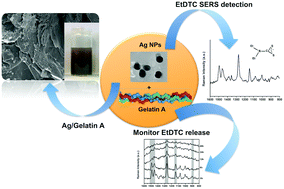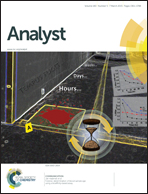Silver-gelatine bionanocomposites for qualitative detection of a pesticide by SERS†
Abstract
The controlled release of pesticides using hydrogel vehicles is an important procedure to limit the amount of these compounds in the environment, providing an effective way for crop protection. A key-step in the formulation of new materials for these purposes encompasses the monitoring of available pesticides in the gel matrix under variable working conditions. In this work, we report a series of bionanocomposites made of Ag nanoparticles (NPs) and gelatine A for the surface enhanced Raman scattering (SERS) detection of sodium diethyldithiocarbamate (EtDTC) as a pesticide model. These studies demonstrate the effectiveness of these substrates for the detection of EtDTC in aqueous solutions in a concentration as low as 10−5 M. We have monitored the Raman signal enhancement of this analyte in bionanocomposites having an increasing amount of gelatine due to their relevance in formulating hydrogels of variable gel strengths. Under these conditions, the bionanocomposites have shown an effective SERS activity using EtDTC, demonstrating their effectiveness in the qualitative detection of this analyte. Finally, experiments involving the release of EtDTC from Ag/gelatine samples have been monitored by SERS, which attest the potential of this spectroscopic method in the laboratorial monitoring of hydrogels for pesticide release.


 Please wait while we load your content...
Please wait while we load your content...